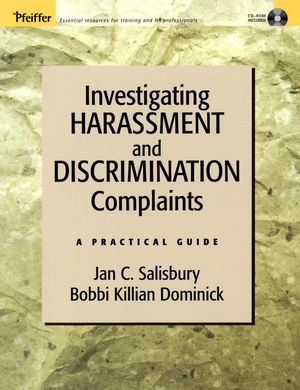Investigating Harassment and Discrimination Complaints: A Practical GuideISBN: 978-0-7879-6874-8
Paperback
338 pages
October 2003, Pfeiffer
 This is a Print-on-Demand title. It will be printed specifically to fill your order. Please allow an additional 10-15 days delivery time. The book is not returnable.
|
||||||
Dedication.
Preface.
Acknowledgment.
Introduction.
PART ONE: ESSENTIAL INFORMATION.
1. Investigator Fears, Motivations, and Jargon.
An Investigator’s Greatest Fears.
An Investigator’s Greatest Motivations.
Interpreting Legal Jargon.
2. The Law of Harassment and What Investigators Need to Know.
Why Investigators Need to Know the Law.
Relevant EEO Laws.
Definition of Harassment Under Title VII.
Employer Liability for Supervisory Harassment and the Affirmative Defense.
EEOC’s Guidance on Supervisory Harassment.
Other Types of Harassment.
Retaliation After the Original Complaint.
Special Problems in Harassment Law.
3. The Psychology of Harassment.
The Nature of Harassment.
Harassers.
Coping with Harassment.
The Impact of Harassment on Individuals and Workgroups.
Environmental Factors Affecting Harassment.
Implications for Investigators.
4. Diversity and Harassment.
The Diversity of Race, Ethnicity, and Other Cultural Differences.
Differences Between Men and Women.
Tips for Investigators.
PART TWO: PRIOR TO THE INVESTIGATION.
5. Characteristics of Effective Investigators.
Unbiased Pursuit of the Facts.
Superior Communication Skills.
Ease with Difficult Behaviors and Emotions.
Legal Knowledge.
Excellent Relationship with Management.
Knowledge of Hierarchy and Culture.
Presentation Skills.
Emotional Maturity and Detachment.
Valuing and Understanding Diversity.
Choosing the Right Investigator.
6. Organizational Settings Conducive to Effective Investigations.
A Dynamic Organizational Model.
Policies to Prevent Discrimination, Harassment, and Retaliation.
Procedures for Investigating Allegations.
Role of Leadership.
Role of Training.
Role of HR and the Investigators.
PART THREE:THE INVESTIGATION.
7. The Investigative Plan.
When to Do an Investigation.
Intake of Complaints.
Developing an Investigative Plan.
Setting Up Interviews.
Size of the Investigation.
Other Legal Issues to Consider.
8. Documentation.
Record Keeping.
Attorney-Client Privilege.
Writing an Investigative Report.
Disseminating the Written Report.
9. Tips and Techniques for Conducting the Investigation.
Confidentiality.
Civil vs. Criminal Investigations.
Conducting the Investigation.
The Interviewing Process.
Interviewing the Complainant.
Interviewing the Alleged Harasser.
Interviewing Witnesses.
Completing the Process.
Gathering Factual Documentation.
10. Making the Determination.
Deciding When You Are Finished.
Policy Violations vs. Violations of the Law.
Determining Credibility.
Deciding What Is Relevant.
Corroborating Evidence.
Boorish Behavior and Bad Management.
Risk Factors.
Making a Determination.
PART FOUR: BEYOND THE INVESTIGATION.
11. Prompt, Corrective Action.
AWorking Definition of Zero Tolerance.
Presenting the Issues to Top Management.
Judging the Severity of the Behavior.
Disciplinary Considerations.
Types of Discipline.
Training for Workgroups.
Training for Individual Harassers.
12. Remedies, Healing, and Follow-Up.
Remedies for Aggrieved Employees.
The Need for Debriefing.
Leading the Debriefing.
Debriefing the Complainant.
Debriefing the Accused.
Debriefing Workgroups.
Debriefing Employees and Witnesses.
13. The Investigator as Witness.
Testifying During Trial.
Surviving Cross-Examination.
Conclusion.
Training Program: Training Internal Investigators.
Training Internal Investigators Handouts.
Appendix.
Sample Policy.
Sample Investigative Forms.
Sample Report.
Federal Cases of Importance for Sexual Harassment Issues.
Federal Cases Addressing the Affirmative Defense, 1998–2002.
Enforcement Guidelines Issued by EEOC.
Policy Guidance on Current Issues of Sexual Harassment (1990).
The U.S. Equal Employment Opportunity.
Commission Enforcement Guidelines.
Bibliography.
Index.
About the Authors.
How to Use the CD ROM.
CD Contents.
Training Program: Training Internal Investigators Handouts.
Handout A: Self-Evaluation Form.
Handout B: Microcosm Respectful Workplace Anti-Harassment Policy.
Handout C: Case Studies.
Handout D: Four Layers of Diversity.
Handout E: Stereotypes and Generalizations.
Handout F: You as a Diverse Entity.
Handout G: Triad Role Play.
Handout H: Forming an Investigative Plan.
Handout I-1: Witness Summary: Willima Michaels.
Handout I-2: Witness Statement: Tom Torrance.
Handout I-3: Witness Summary: David Lee.
Handout I-4: Witness Summary: B.J. Raymond.
Handout I-5: Witness Summary: Michelle Cline.
Handout J-1: Role Play Preparation and Feedback Forms.
Handout J-2: Role Play Feedback Guidelines.
Handout K: Remedies, Healing, and Aftermath.
Handout L: Debriefing the Workgroup Exercise.
Handout M: Your Organization’s Follow-Up Issues.
Sample Policy.
Sample Investigative Forms.
Investigation Activity Log.
Investigator’s Checklist.
Checklist for Interview with Complainant.
Checklist for Interview with Accused.
Checklist for Interviews with Witnesses.
Sample Report.



